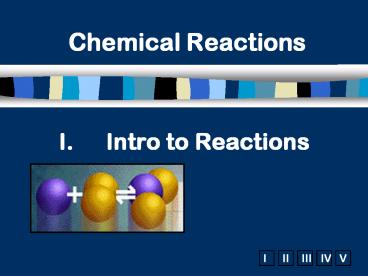Intro to Reactions - PowerPoint PPT Presentation
1 / 22
Title:
Intro to Reactions
Description:
Chemical Reactions Intro to Reactions A.Signs of a Chemical Reaction Evolution of heat and light Formation of a gas Formation of a precipitate Color change B.Law of ... – PowerPoint PPT presentation
Number of Views:112
Avg rating:3.0/5.0
Title: Intro to Reactions
1
Intro to Reactions
- Chemical Reactions
2
A.Signs of a Chemical Reaction
- Evolution of heat and light
- Formation of a gas
- Formation of a precipitate
- Color change
3
B.Law of Conservation of Mass
- mass is neither created nor destroyed in a
chemical reaction
- total mass stays the same
- atoms can only rearrange
4 H 2 O
4 H 2 O
36 g
4 g
32 g
4
C. Chemical Equations
- AB ? CD
REACTANTS
PRODUCTS
5
III. Types of Chemical Reactions
- Chemical Reactions
6
A. Combustion
- the burning of any substance in O2 to produce heat
A O2 ? B
CH4(g) 2O2(g) ? CO2(g) 2H2O(g)
7
A. Combustion
- Products
- contain oxygen
- hydrocarbons form CO2 H2O
Na(s) O2(g) ?
Na2O(s)
4 2
C3H8(g) O2(g) ?
CO2(g) H2O(g)
5 3
4
8
B. Synthesis
- the combination of 2 or more substances to form a
compound - only one product
A B ? AB
9
B. Synthesis
- H2(g) Cl2(g) ? 2 HCl(g)
10
B. Synthesis
- Products
- ionic - cancel charges
- covalent - hard to tell
Al(s) Cl2(g) ?
AlCl3(s)
2 3 2
11
C. Decomposition
- a compound breaks down into 2 or more simpler
substances - only one reactant
AB ? A B
12
C. Decomposition
- 2 H2O(l) ? 2 H2(g) O2(g)
13
C. Decomposition
- Products
- binary - break into elements
- others - hard to tell
KBr(l) ?
K(s) Br2(l)
2 2
14
D. Single Replacement
- one element replaces another in a compound
- metal replaces metal ()
- nonmetal replaces nonmetal (-)
A BC ? B AC
15
D. Single Replacement
- Cu(s) 2AgNO3(aq) ? Cu(NO3)2(aq) 2Ag(s)
16
D. Single Replacement
- Products
- metal ? metal ()
- nonmetal ? nonmetal (-)
- free element must be more active (check activity
series)
Fe(s) CuSO4(aq) ?
Cu(s) FeSO4(aq)
Br2(l) NaCl(aq) ?
N.R.
17
Activity Series
18
E. Double Replacement
- ions in two compounds change partners
- cation of one compound combines with anion of the
other
AB CD ? AD CB
19
E. Double Replacement
- Pb(NO3)2(aq) K2CrO4(aq) ? PbCrO4(s) 2KNO3(aq)
20
E. Double Replacement
- Products
- switch negative ions
- one product must be insoluble (check solubility
table)
Pb(NO3)2(aq) KI(aq) ?
PbI2(s) KNO3(aq)
2
2
NaNO3(aq) KI(aq) ?
N.R.
21
Identify the type of Rxn
a) Mg 2HCl ? MgCl2 H2 b) 3Ca N2 ?
Ca3N2 c) NH4NO3 ? N2O 2H2O d) 2BiCl3 3H2S ?
Bi2S3 6HCl
22
Identify type of Rxn
- e) 2C4H10 13O2 ? 8CO2 10H2O
- f) 6O2 C6H12O6 ? 6CO2 6H2O
- h) Cr2(SO4)3 6NaOH ? 2Cr(OH)3 3Na2SO4































